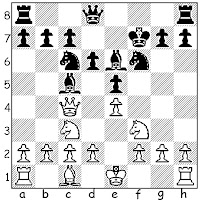Fortunately, I had given the question some thought previously in this blog.
So we have 1.e4 e5 2.Nf3 Nc6 3.Bc4 Nf6 4.0-0, which has more going for it than is generally realized.International Master Tim Harding, writing in his "Kibitzer" column at ChessCafe, noted4 0-0 is not a move you will see played by experienced players; it is simply not direct enough.International Master Jan Pinski, in Italian Game and Evans Gambit, was even more dismissive
4.0-0 is completely toothless, and Black can do as he pleases.Perhaps the second player will be so lulled by the move that he will play 4...Bc5, when 5.Bxf7+ Kxf7 transforms the game into a "modern" Jerome Gambit variation (1.e4 e5 2.Nf3 Nc6 3.Bc4 Bc5 4.Bxf7+ Kxf7 5.0-0 Nf6)? In this line, the updated New Year's Database has 548 games. White scores 39%.
Bringing those statistics up to date, The Database [the updated New Year's Database] now has 3,181 games with 1.e4 e5 2.Nf3 Nc6 3.Bc4 Bc5 4.Bxf7+ Kxf7 5.0-0 Nf6, with White scoring 42%.
Then there is the post Chess Brawl
Facing the Two Knights Defence [1.e4 e5 2.Nf3 Nc6 3.Bc4 Nf6 4.0-0], White offers his opponent the chance to play the Boden Kieseritzky Gambit with 4...Nxe4 5.Nc3 Nxc3 6.dxc3, etc. The Database has games with GeniusPawn playing this line, going back to 2000.
4...Bc5Black declines, but then faces a Jerome-ish response.
5.Bxf7+ Kxf7 6.Nxe5+ Nxe5
This unusual position has only occurred 4 times in The Database, a collection of over 24,500 games.
It is as if White were playing Alonzo Wheeler Jerome's original intention, 1.e4 e5 2.Nf3 Nc6 3.Bc4 Bc5 4.Bxf7+ Kxf7 5.Nxe5 and then decided, before playing 6.d4 and risking 6...Qh4 (see "Danger? He laughs at danger!"), that he would first 0-0, allowing Black to insert ...Nf6...
Then, there is Strike First!
It is worth taking a minute to go back to the post "Jerome Gambit vs Two Knights Defense (Part 4)"
4...Bc5 5.Bxf7+
5...Kxf7
White has transposed to a "modern" variation of the Jerome Gambit [i.e. not 5.Nxe5+], 1.e4 e5 2.Nf3 Nc6 3.Bc4 Bc5 4.Bxf7+ Kxf7 5.0-0 Nf6. Bill has 11 examples in The Database, all wins. He decides to throw Nxe5+ in, anyhow.
6.Nxe5+ Nxe5 7.d4
It is the pawns (White has two extra) vs the pieces (Black, temporarily, has two more), a typical Jerome Gambit imbalance. Bean counters look elsewhere.
More related games can be added with the post Okay With the Delay
This reasonable move [4.0-0] was looked at in "Jerome Gambit vs Two Knights Defense (Part 4)".
Bill has also played 4.Nc3 Bc5 5.Bxf7+ Kxf7 as in Wall,B - Samvazpr, Chess.com 2010 (0-1, 25); Wall,B - Roberts, Chess.com, 2010 (1-0, 17); Wall,B - DarkKnight, Cocoa Beach, FL 2012 (1-0, 23); Wall,B - Guest1459913, PlayChess.com, 2013 (1-0, 38); Wall,B - Hamilton,E, FICS 2011 (1-0, 22); Wall,B - Guest1872464, PlayChess.com, 2014 (1-0, 30).
Of course, Philidor1792 has played 4.Bxf7+ here, any way, in 3-minute games.
4...Bc5
Or 4...Nxe4 5.Bxf7+ as in Wall, B - NTLZ, FICS, 2010 (0-1, 42).
Now there is a chance for a Delayed Jerome Gambit.
5.Bxf7+
So, maybe there is something worth looking at in 4.0-0, after all - especially since I have already looked at it, a bit.







.png)
.png)
.png)





































